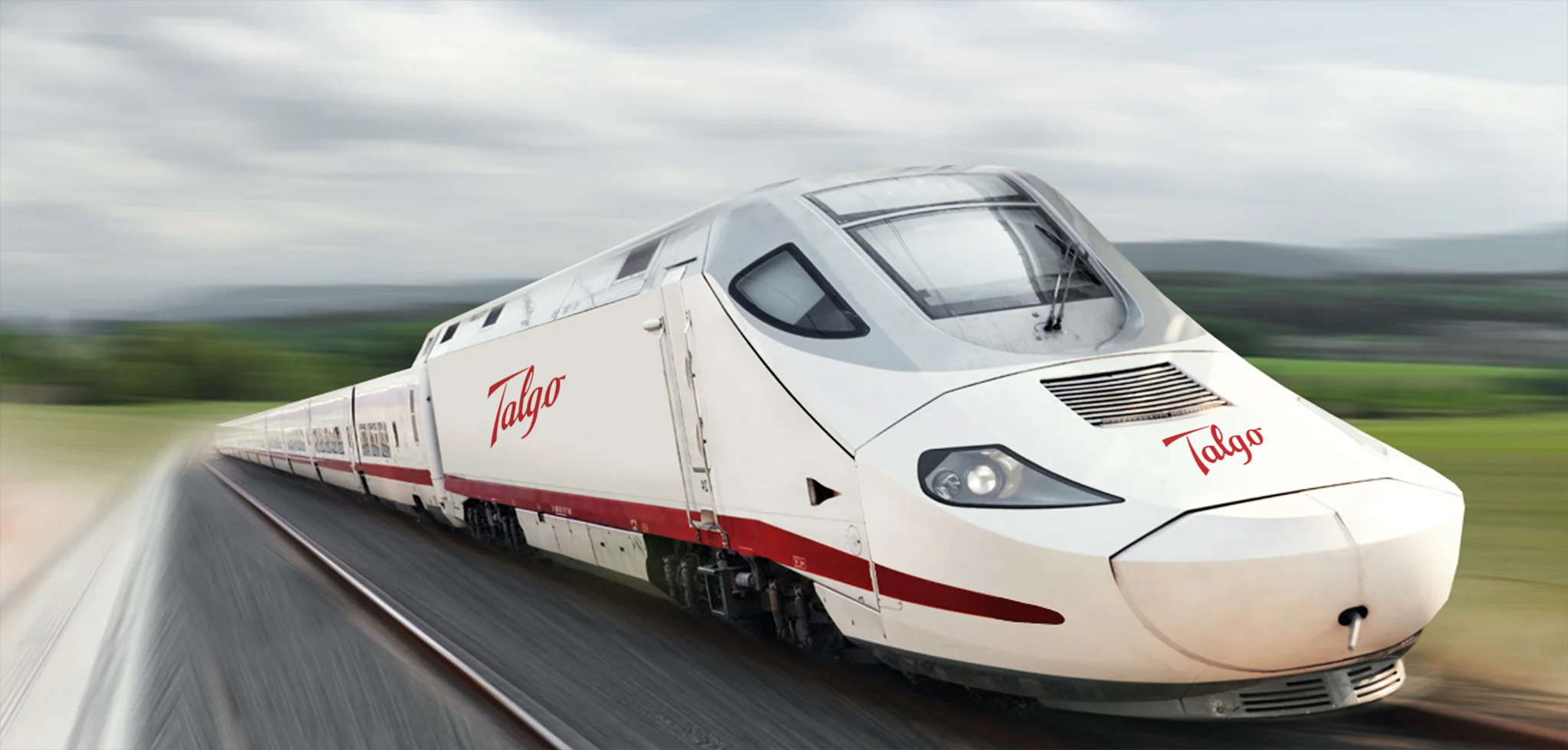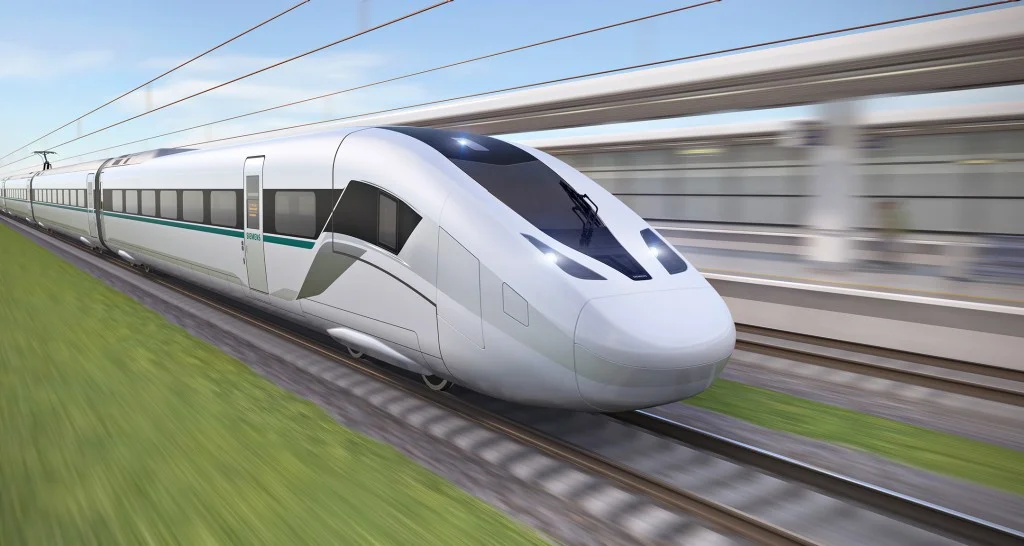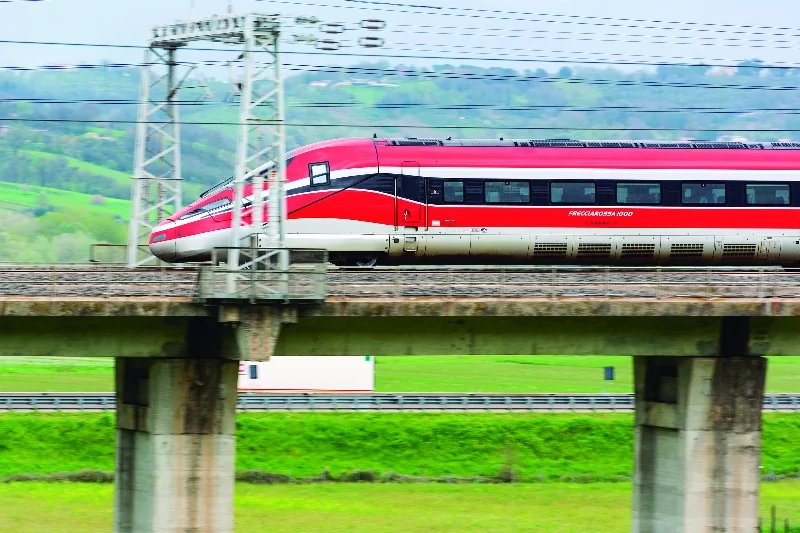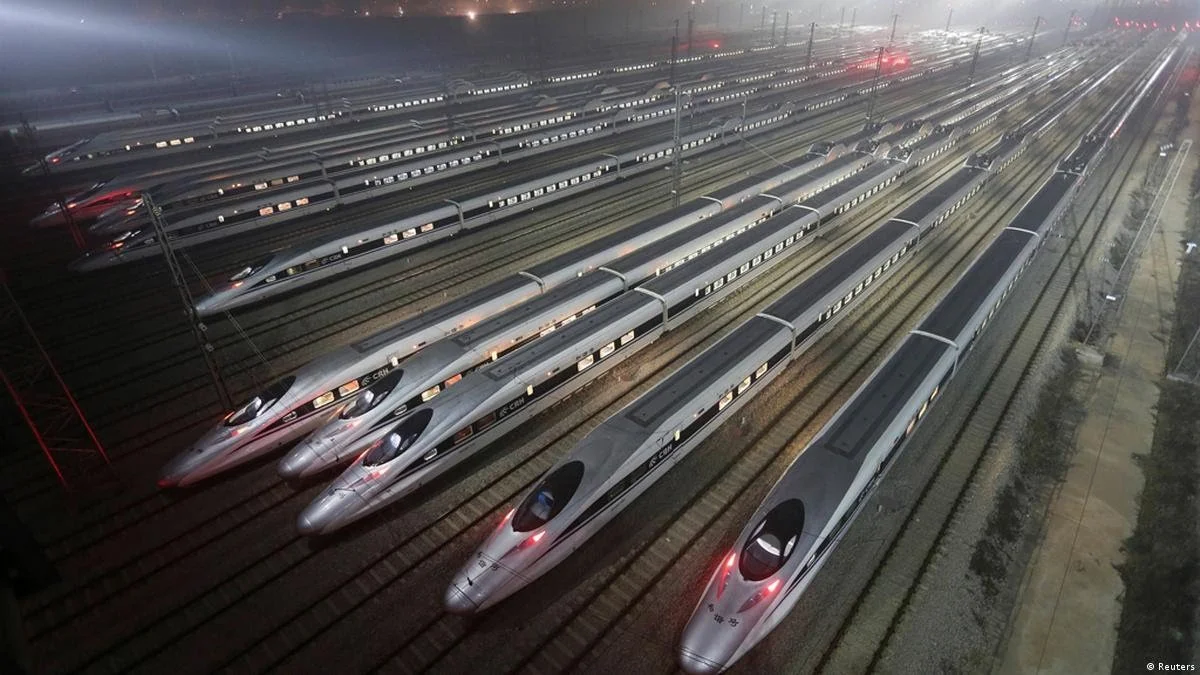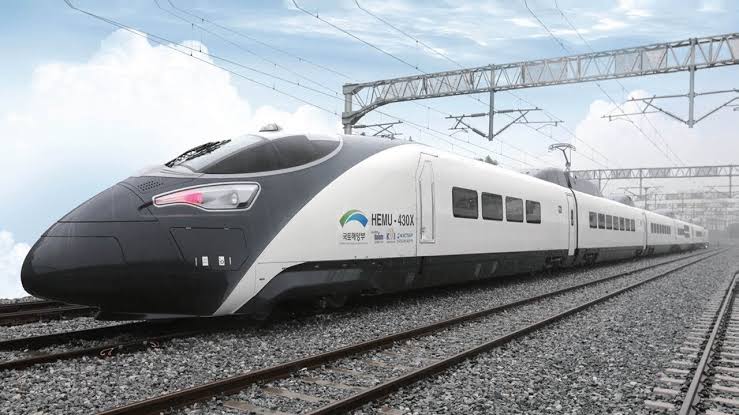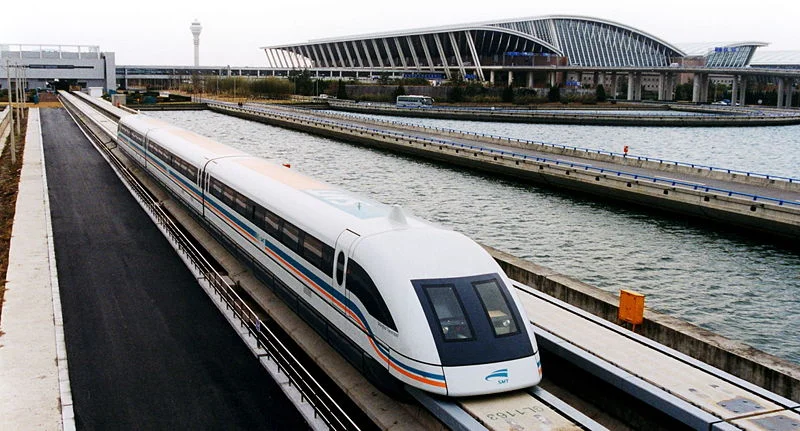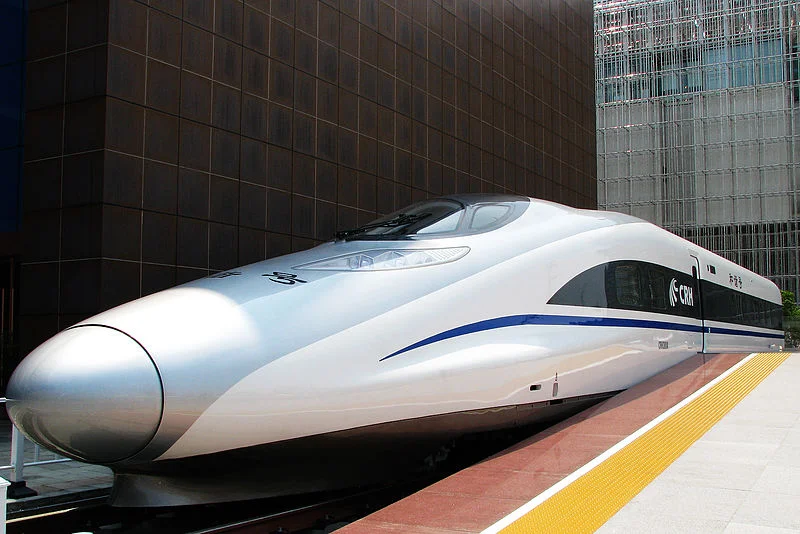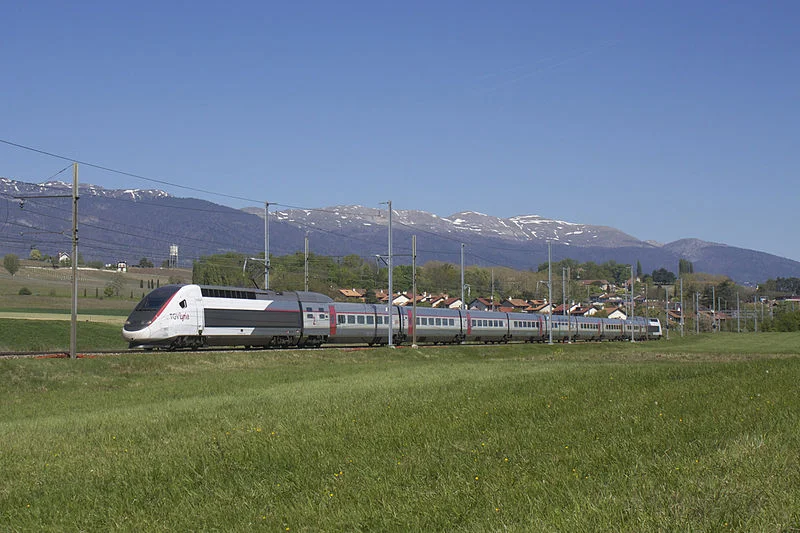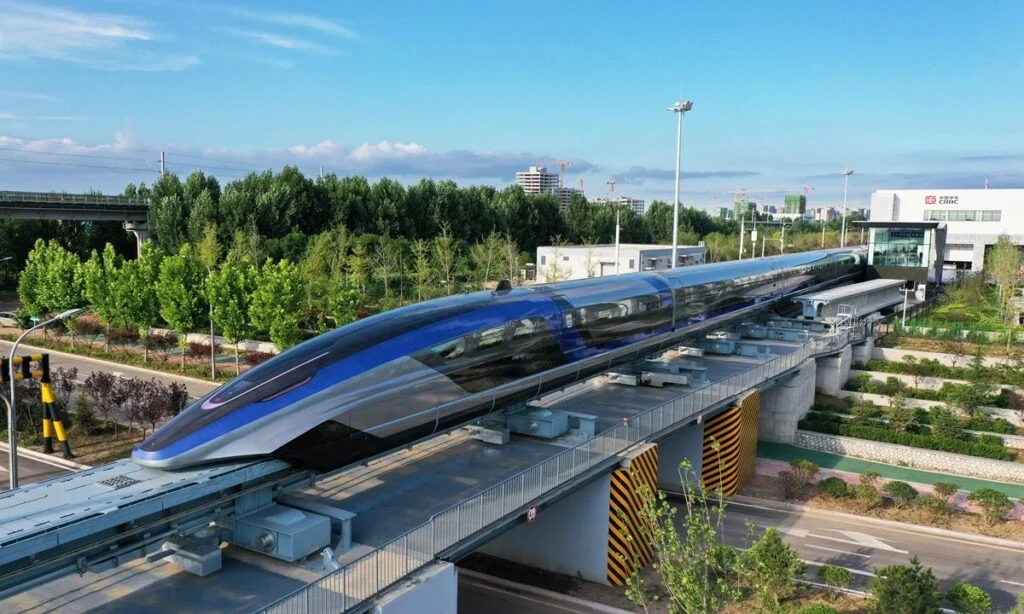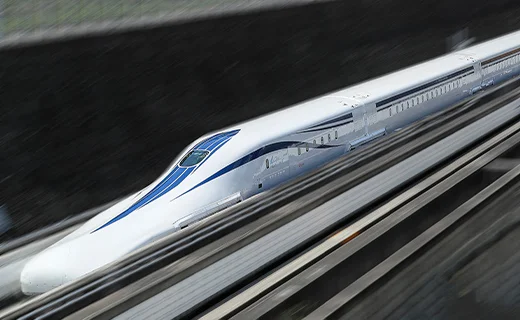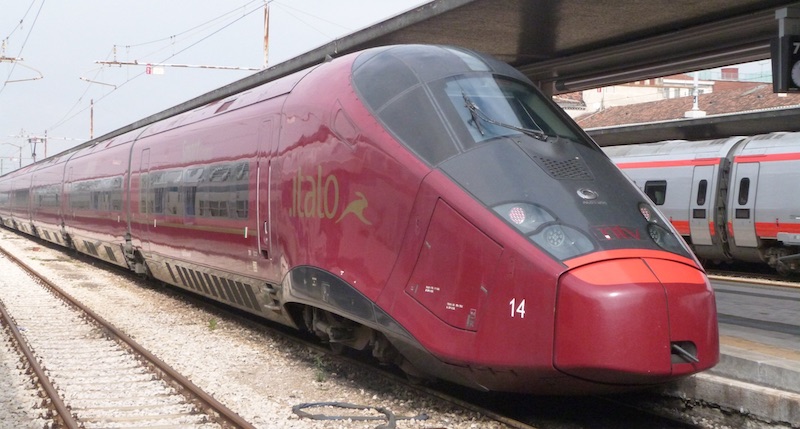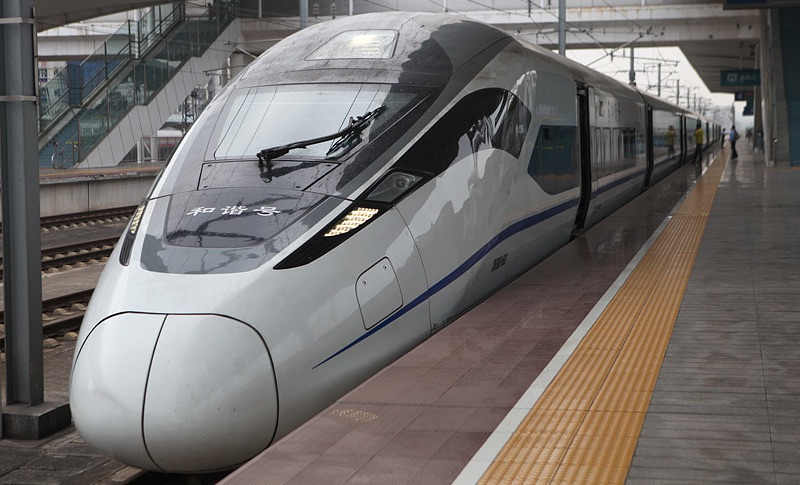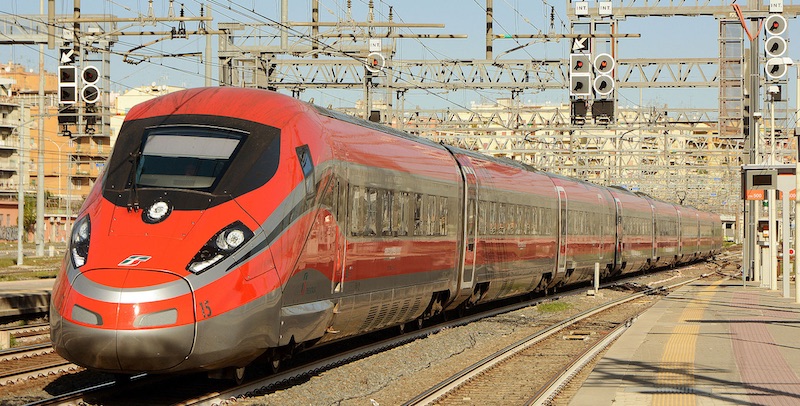Of course, trains can’t fly over oceans like airplanes. But that doesn’t mean trains can’t run as fast as planes. Fortunately, some trains in this modern world are as fast as planes. Followings are the list of ten fastest trains in the world.
10 Talgo 350, 217 mph, Spain
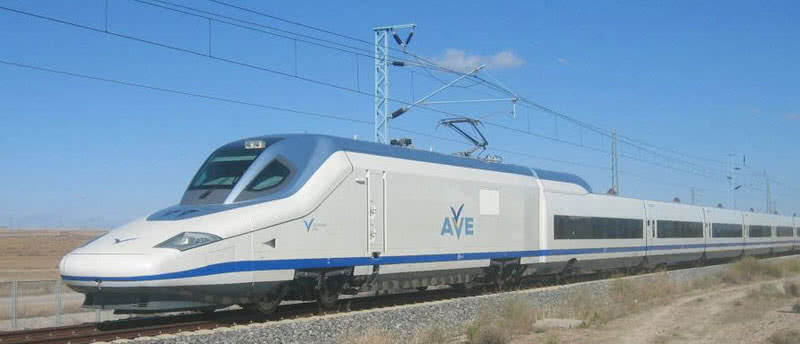
Patentes Talgo, a Spanish company, developed Talgo 350 (T350). This very high-speed train entered the service with the name RENFE AVE Class 102. Besides, it started its journey on the Madrid-Barcelona and Madrid-Valladolid lines in Spain. The train is also known as Pato as its nose resembles the beak of a duck.
Spain commenced the trial runs of the entirely constructed prototype in 2002. Additionally, the designers designed the T350 train to be optimally aerodynamic to handle air pressure and air currents at high speeds. Its main feature is the high redundancy level in traction between rail and auxiliary systems. Moreover, it has a lightweight, airtight, and pressurized car body to comfortably pass through tunnels and crossings.
- Country: Spain
- Top speed: 217 mph
- Manufacturer: Consortium of Patentes Talgo and Bombardier Transportation
- Train length: 656 ft 2 in
- Open Date: February 2005
9 AGV Italo, 224 mph, Italy
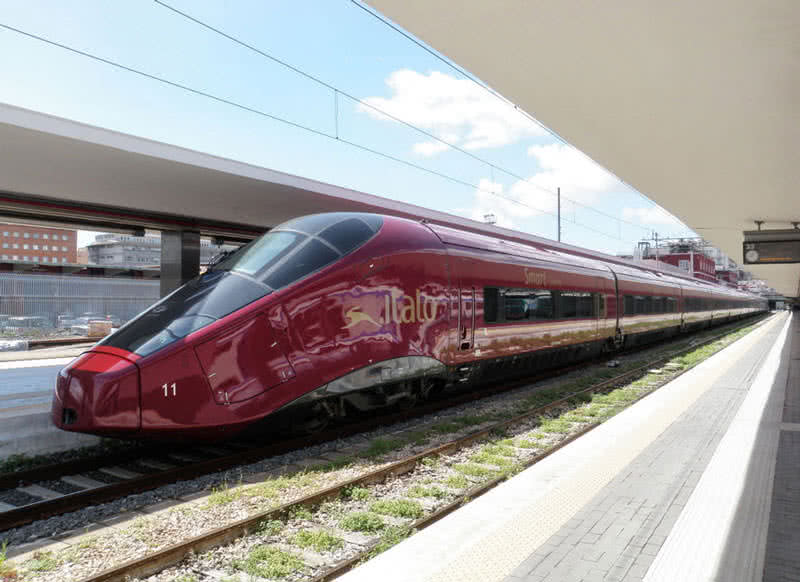
The first train in the AGV Series, Italo AGV, entered into service in April 2012. Officials considered it to be the most modern train in Europe. Besides, this train operates with the highest speed of 186 mph on Italy’s different high-speed lines. However, the AGV can run up to 224 mph. AGV trains consist of a fewer number of bogies per train that reduce the maintenance costs.
We can find more space inside of this high-speed train because it uses permanent-magnet synchronous motors. Additionally, the passengers of AVG Italo trains can travel between Rome and Naples in just an hour. Moreover, the trail follows the European TSI interoperability standard, which offers safety, reliability and environmental protection, availability, health, and technical compatibility.
- Country: Italy
- Top speed: 224 mph
- Operator: Nuovo Trasporto Viaggiatori
- Manufacturer: Alstom
- Train length: 433 feet 0.85 inch
- Open Date: April 2012
8 Siemens Velaro, 250 mph, Spain
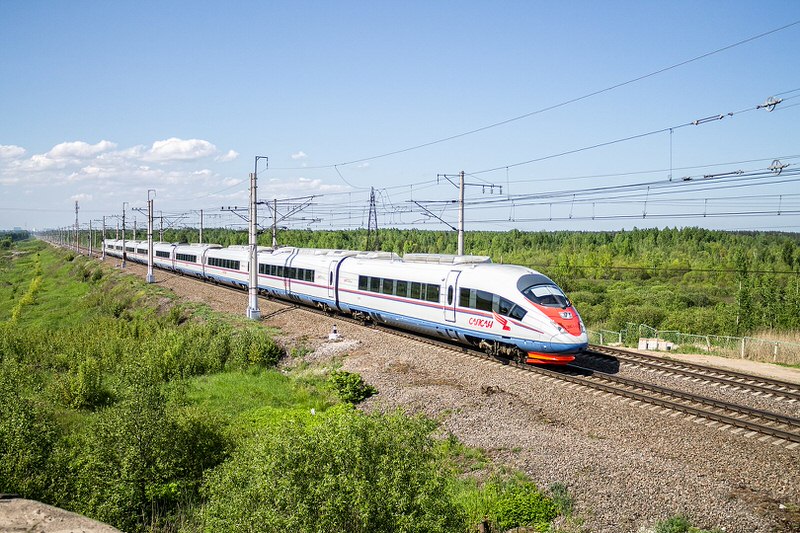
The german-based company, siemens, developed thE world’s fastest high-speed conventional train. Additionally, the Krefeld-Uerdingen factory in Germany manufactured it. These trains’ five variants include Velaro E, Velaro RUS, Velaro e320, Velaro D, and Velaro CRH3. Velaro CRH3 and Velaro E are operational in China and Spain, respectively.
Moreover, the efficiency, sustainability, and passenger comfort and convenience is a major advantage. Velaro RUS, Velaro D, and Eurostar will become operational in Russia, Germany, and the UK and the future. We can find these trains are fully operable in snow and ice. Besides, the driver’s clear visibility in various snow conditions is one of the main features.
- Country – Spain
- Top speed – 250 mph
- Operators: Germany, Spain, China, the UK, Russia
- Builder: Siemens
- Train Length:656 ft to 1,280 feet.
- Open date: 2006
7 Frecciarosa 1000, 250 mph, Italy
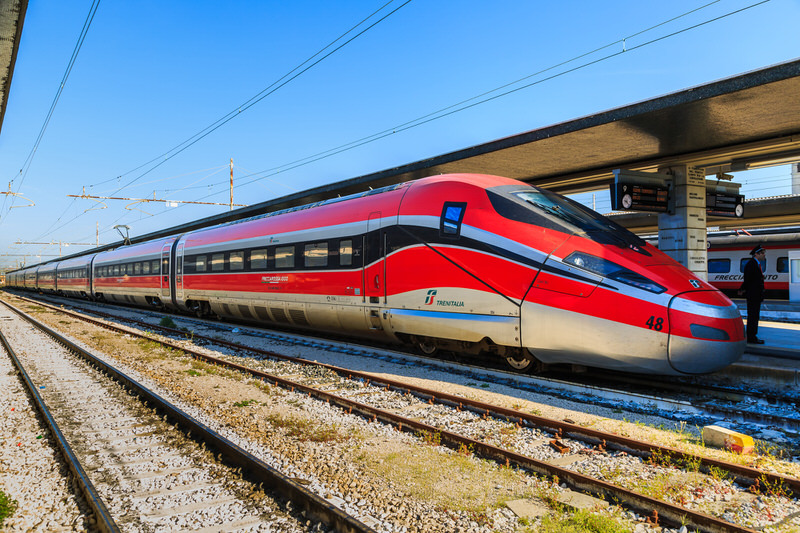
Image credit: teptong/Depositphotos
Italy designed it with a top speed of 250 mph and a high commercial speed of 220 mph. But it is currently certified for 190 mph, is also known as ETR 400. Bombardier built the ‘Red Arrow’ train in partnership with AnsaldoBreda. Additionally, this advanced model train provides long-distance passenger service on high-speed lines. It features mainly interoperability, safety, and comfort.
The newest high-speed train started its first journey from Milan to Rome on April 25, 2015. It is also a silent train that creates less noise. Moreover, the Frecciarossa 1000 is the world’s first high-speed train to have obtained the Environmental Product Declaration (EPD), as it can limit CO2. It also uses the ERTMS / ETCS for controlling the train that eliminates human error.
- Country: Italy
- Top speed: 250 mph
- Operator: Trenitalia
- Manufacturer: AnsaldoBreda and Bombardier Transportation
- Train length: 662.73 feet
- Open Date: April 25, 2015
6 Fuxing Hao CR 400AF/BF, 260 mph, China
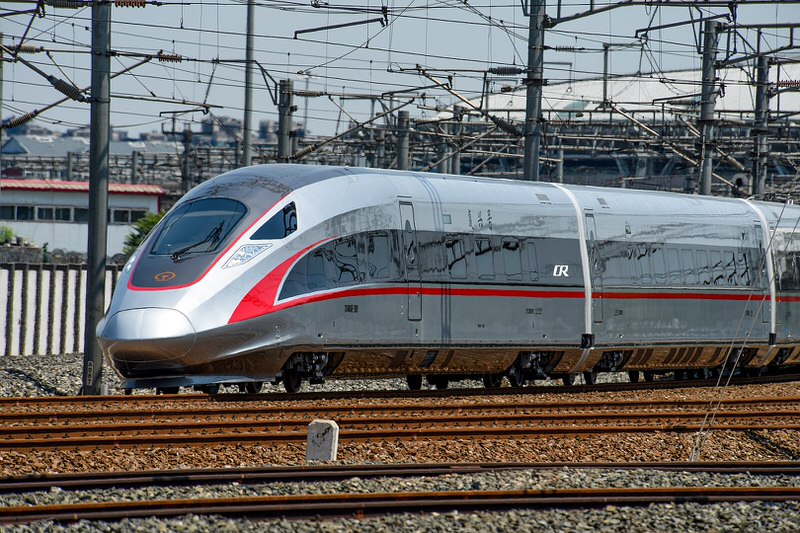
The CR400AF train mainly features a streamlined body for low drag and high speed. We can find both sides of its car body as silver-gray background with red lines. So these decorations make this train looking more elegant and powerful. The CR400BF train provides a protruding vitreous head with gentle sides. Additionally, we can find the gold ribbons outlining its pure white background body.
In 2007, China officially introduced the Fuxing Hao CR 400AF/BF high-speed train into service on the Beijing Shanghai high-speed railway line. Besides, the train needs only 4 hours to run from Beijing south to Shanghai Hongqiao. People said The CR 400 AF as ‘Dolphin Blue’ and CR 400 BF as ‘golden phoenix.’
- Country – China
- Top speed- 260 mph
- Manufacturer: CRRC Qingdao Sifang, CRRC Changchun Railway Vehicles, CRRC Tangshan Railway Vehicle
- Operator: China Railway Corporation Kereta Cepat Indonesia, China
- Train length: CR400AF: 685 ft 8 in, CR400BF: 685 ft 11 in
- Open Date: June 2015
5 HEMU-430X, 267 mph, South Korea
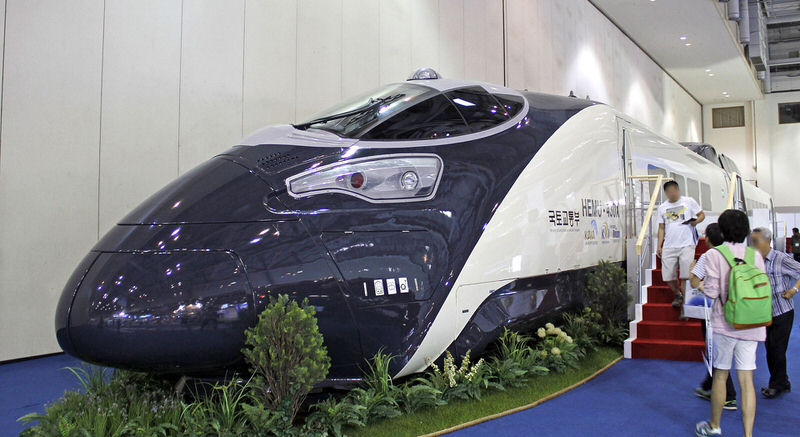
HEMU-430X is standing for the High-Speed Electric Multiple Unit 430 km/h experimental. It is an experimental South Korean high-speed train designed for speeds up to 267 mph. But, it achieved 261.846 mph in a test run on March 31, 2013. Moreover, this high speed makes South Korea the world’s fourth country after France, Japan, and China to develop the fastest train running above 260.976 mph.
The newest feature of this train compared to older high-speed trains is mainly distributed traction. The trains’ commercial versions include the EMU-260 and EMU-320. South Korea will deliver these versions to Korail in 2020-2021. Additionally, they unveiled HEMU-430X on May 17, 2012. They also expect it to undergo around 100,000 km of testing up to 2015.
- Country: South Korea
- Top speed: 267 mph
- Manufacturer: Hyundai Rotem
- Operator: Korail
- Train length: 484 feet
- Open Date: May 17, 2012
An Email A Day Keeps Boring Away
Grab our Newsletter. Never miss a list from TMW.
4 Shanghai Maglev, 268 mph, China
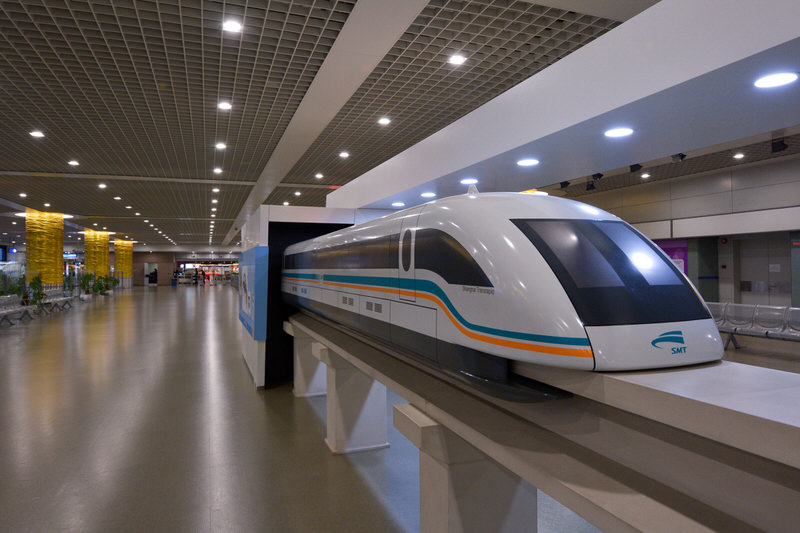
Image credit: lucidwaters/Depositphotos
It is a magnetic levitation train that helps people travel from Pudong International Airport right to the city’s heart. Besides, this train’s breakneck speed will impress us and have an exciting first experience in the city. In 2003, Guinness Records enrolled it to be the world’s fastest train in commercial use. Its energy consumption is only half that of buses and a quarter that of airplanes.
The trains don’t touch the railway line, which makes the sound quieter than other trains. This third oldest maglev line came after the British Birmingham Maglev line and German M-Bahn line. Additionally, this train doesn’t touch the railway line. Therefore, the sound makes it quieter than other trains. Like an airplane, it has very modern, clean, and comfortable inside.
- Country: China
- Top speed: 268 mph
- Operator: Shanghai Maglev Transportation Development Co., Ltd
- Manufacturer: A joint venture of Siemens and ThyssenKrupp
- System length: 18.02 mi
- Open Date: December 31, 2002
3 Harmony CRH 380A, 302.0 mph, China
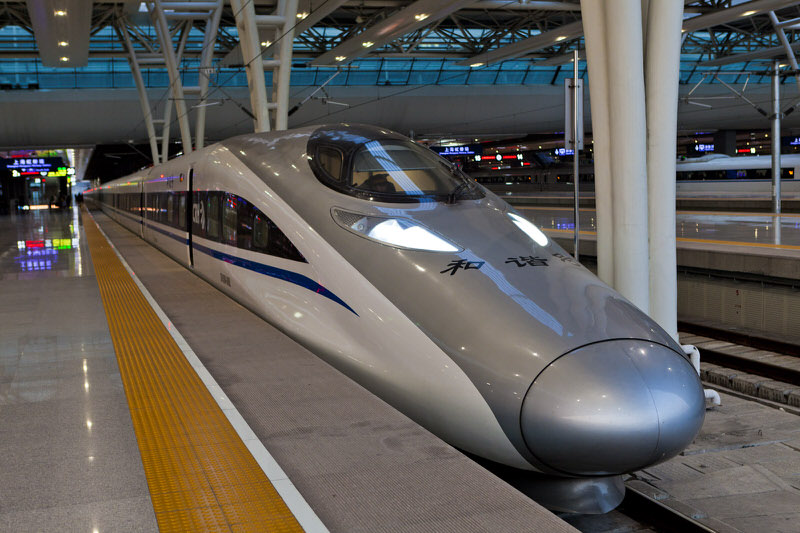
China designed the CRH380A to operate at a cruise speed of 217 mph and a maximum speed of 236 mph in commercial service. Its regular service takes place on the route between Shanghai and Nanjing. Additionally, this design reduces aerodynamic pressure. Its vibration-free bodies make a more comfortable passenger experience. It has low-weight aluminum alloy bodies with fish-head fronts.
The CRH 380A trains can carry around 494 passengers at a time. We can find a VIP sightseeing spot near the driver’s cabin that allows travelers to view the running train. Moreover, China also incorporates these trains with advanced noise control technology like new sound-absorbing and insulating materials in its construction.
- Country: China
- Top speed: 302.0 mph
- Operator: China Railway
- Manufacturer: CRRC Qingdao Sifang
- Train length: 666 feet
- Open date: 2010
2 TGV POS, 357.2 mph, France
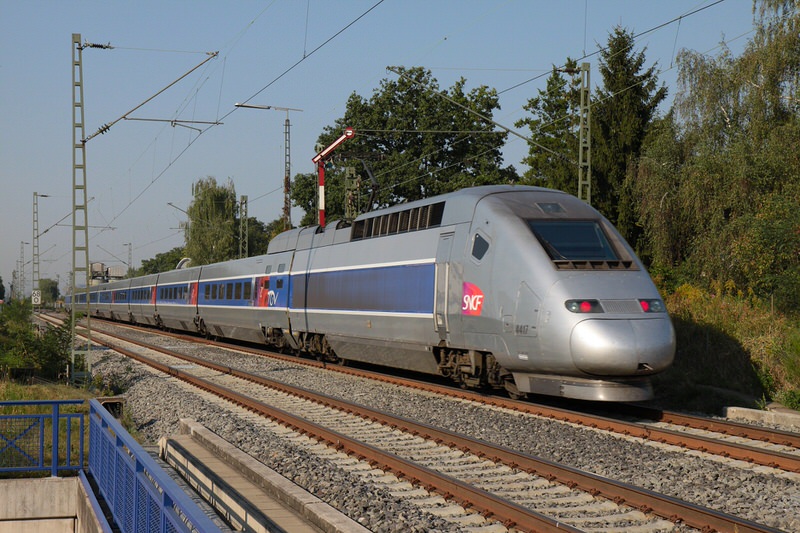
Alstom built this TGV train for the French national rail company (SNCF) on France’s high-speed rail lines. Besides, the TGV POS links France with southern Germany and Switzerland. In Switzerland, it runs from Basel to Zurich and Vallorbe to the Lausanne line that coming from Paris. Additionally, the POS 4402 train set a new world speed record on April 3, 2007.
Its asynchronous motors help the individual motor’s isolation in a powered bogie in case of failure. Additionally, SNCF numbered it in the 4400 series. These are just faster and more efficient TGVs. Like TGV Duplex, the outside bodywork on the power-cars. Besides, France started the train’s service in 2006. Moreover, France commissioned the first TGV train on Paris to Geneva itinerary in 1981.
- Country- France
- Top speed – 357.2 mph
- Operator – French national rail company SNCF
- Manufacturer: Alstom
- Train length: 657 ft
- Open Date: 2006
Related Articles
1 L0 Series Maglev, 375 mph, Japan
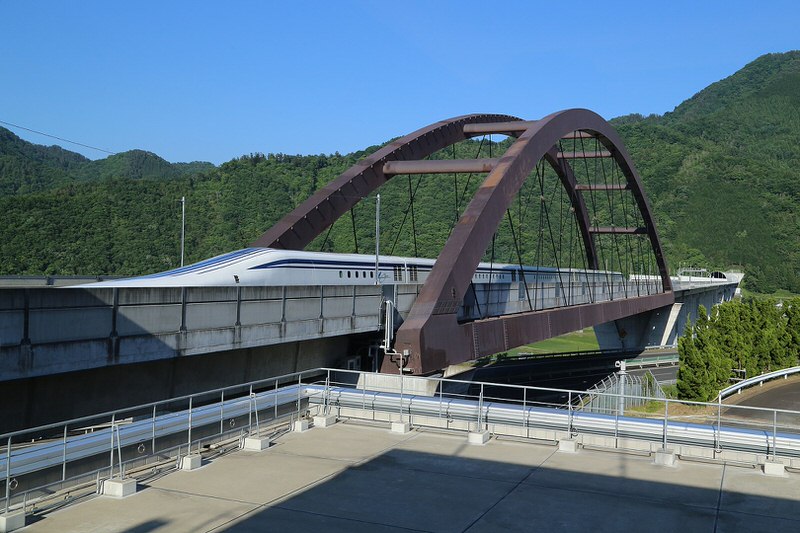
We can easily distinguish it by its too long nose that is 49 ft in length. This feature helps the L0 Series Maglev to reduce drag, increase speed, and decrease energy consumption. Additionally, L0 Series Maglev holds the land speed record at 375 mph that it achieved on April 21, 2015.
Besides, this train broke a speed record of 361 mph that another Japanese maglev, the MLX01, set in December 2003. This one of the fastest trains will begin its commercial operation in Tokyo and Osaka. This train will also require only 40 minutes to run from Tokyo to Nagoya, covering 178 miles. Moreover, we expected the first section to Nagoya to be ready by 2027.
- Country: Japan
- Top speed: 375 mph
- Operator: JR Central
- Manufacturer: Mitsubishi Heavy Industries, Nippon Sharyo
- Train length: 980.971 feet
- Open Date: November 2012
What is the maximum speed for trains? In 2015, the Japanese maglev train L0 Series achieved an absolute railway speed record of 375 mph (602 km/h). In reality, there are about 10 super-fast trains with a speed greater than 200 mph. In this comparative review, we have collected such fastest trains in the world. You will find out what are the fastest trains in the world, what are their maximum speeds, in which countries they operate, who their manufacturer is and a lot of other interesting information.

In the post-war years when the baby boomers were kids, the word “train” used to evoke different images. These were images of colossal lumbering beasts such as the Flying Scotsman and Union Pacific Big Boy with six feet tall cast iron wheels and huge pistons heaving to and fro. From 1964 that all changed. The first “bullet train”, formally known as Shinkansen, ran in 1964 between Tokyo and Osaka. Ever since, the world has viewed railways differently.
Gen Z has always associated trains with a long silver snake elegantly speeding its way through Europe or Honshu Island and, more recently, across China. Bullet train action sequences have also proved popular with moviegoers – Mission Impossible with Tom Cruise/Ethan Hunt hanging on to Eurostar at over 150 miles an hour comes to mind.
We take a look at the fastest trains in the world.
Fastest Trains in the World Comparison (Data for 2023):
10. Eurostar e320 – the United Kingdom, 200 mph

Source: press.siemens.com
The British Rail Class 374, otherwise known as Eurostar e320, was unveiled by Siemens in 2015. The interiors are designed by the famed Italian automotive stylist outfit Pininfarina. The train can carry 900 passengers in comfort, an increase of 20 over its predecessor Eurostar e300.
The e320s operate between London St Pancras and Paris Gare du Nord . It can complete the 305 mile trip in 2 hours and 16 minutes, reaching the highest 200 mph speed under the English Channel. There is also a service between London and Brussels.
This e320 is fast and cuts down travel time through the Channel Tunnel, making it preferable to flying. The frequency of operation is also high, with a train every hour from London to Paris every day of the week.
Eurostar is reliable, and most trains arrive on time or at most 15 minutes late. It is remarkably eco-friendly, with 90% fewer emissions than London to Paris flight per passenger.
9. Korail KTX – South Korea, 205 mph

Source: englishspectrum.com
The KTX Sancheon is built by Hyundai and operated by Korail from 2009. With a top speed of 205 mph, the Sancheon is an update over the previous KTX-I and the first to be designed and built in South Korea in the run-up to the 2018 Incheon Winter Olympics.
With a demure blue and white livery, the superfast expresses are quite a common sight speeding across the countryside at lightning speed. With two classes – first and the standard – they are a hugely popular form of travel through the nation.
The Sancheon operates with 8 or 16 cars, and the seats are rotating. You could travel backward or forwards as it suits you since this provides more leg space.
The trains run on five lines Gyeongbu, Honam, Gyongjeon, Jeolla, and Gangneung, connecting the capital Seoul to Busan, Mokpo, Gwangju, Gangneung, and Shinju.
8. Deutsche Bahn ICE – Germany, 205 mph

Source: isgedr.com
The InterCity Express or ICE 4 is operated by Deutsche Bahn. They connect Berlin, Munich, Hamburg, Stuttgart, and other major German cities. You can also take an ICE train to Austria, Brussels, Amsterdam, and several other locations outside Germany.
Cool, classy interiors are spacious and well designed. The train uses 30% less energy due to better aerodynamics.
Developed by Siemens in collaboration with Bombardier, each train can accommodate upwards of 450 seats. The ICE 4 runs on an innovative power car concept with as many as 24 driven axles spread across six out of twelve compartments.
DB has placed an order worth Euro 1 billion with Siemens for 30 supplementary trains to run on new lines between Dortmund and Munich. Depending on the chassis design, some of them can be used later to reach London through the Channel Tunnel.
7. Haramain Western Railway – Saudi Arabia, 217 mph

Source: buzz24feed.com
The Haramain high-speed railway, also known as Mecca-Medina high-speed corridor, is 450 km or 280 miles long and was inaugurated in 2018.
It has cut down the travel time between the two holiest sites of Islam to under two hours. The fleet currently consists of 35 trains, and with a capacity of 400 passengers, each can theoretically ferry 60 million passengers annually.
The five stations on the route are Mecca, Medinah, Jeddah, King Abdullah Economic City, and King Abdulaziz International Airport. The rolling stock is Talgo 350 developed for RENFE and made in partnership with Bombardier. With a distinctive snout that makes it look like a dolphin, the silver streak speeding across the hot desert sand is a sight to behold.
6. Talgo 350 – Spain, 217 mph

Source: talgo.com
The Spanish Talgo 350 is built by Patentes Talgo and runs between Madrid and Barcelona. The train has a curious nickname,”Pato,” meaning duck in Spanish. This is due to its distinctive nose cone that resembles a duckbill.
During its trial runs, the express managed a speed of 228 miles per hour, though, in regular service from 2005, that is restricted to 215 mph. The design focuses on safety as well as high speed. There is minimum rolling of the coaches, and an innovative tilting mechanism provides stability around corners.
There are several classes – Club (with 14-26 seats), First (with 26 seats), and Coach with 36. Each seat comes with reading lamps, reclining back, and power points for recharge of laptops and cell phones.
5. AGV Italo – Italy, 223 mph

Source: flikr.com
At 223 mph, it holds the distinction of being the fastest train in Europe. Nicknamed “Ferrari of the tracks,” the plum red trains are run by Nuovo Trasporto Viaggiatori, a consortium headed by the erstwhile president of Ferrari, Luca Cordero di Montezemolo. The train itself is built by Alstom AGV, and instead of having an engine at the front and rear is powered by axles throughout the rake making it very fast.
The train is also lighter, and by some accounts, shaves off 70 tons from similar designs by Talgo and Siemens. The compartments are 9 feet wide, making it easy to maneuver with luggage, and even the general compartments have luxurious leather seats.
It first started running on the Naples to Milan route and later extended the service to Turin and Venice.
4. Shinkansen E5, H5 Series – Japan, 224 mph

Source: japanrailandtravel.com
The legend, the first and for many purists, the only “bullet train.” Japan is the birthplace of the modern high-speed railways’ network. The network centers around Tokyo and stretches to Sapporo in the north to Nagasaki in the south. There are nine operational routes with another four set to come into operation by 2023.
There are several models of bullet trains of which the H5 is the latest. Entering service in 2016, the fastest bullet train has an appearance not unlike the Talgo 350.
The cars are silent due to excellent acoustic suppression, and all the seats face forward. The Japan Rail Pass makes travel by the H5 very economical.
Each ten car train has eight Ordinary Cass compartments seating five abreast, a Green Class seating four abreast, and a First Class seating three abreast. Seats are both reserved and unreserved. Many of the lines do have exceptionally high demand, and it is advisable that interested traveler books first.
3. Harmony CRH 380A – China, 236 mph

Source: wikipedia.org
The top three come from where else but China. The Middle Kingdom has made rapid strides in the past forty years and likes to show its progress through technological might. Its traditional rival over centuries, Japan had to surrender the crown to China a decade ago.
The Harmony CRH 380A is the second fastest operating wheeled train in the world. Designed by the China South Locomotive & Rolling Stock Corporation Limited (CSR), it entered service before the Beijing Olympics. The train runs in various configurations from eight to sixteen compartments and even comes with superb six-seat executive compartments. Each has a bar and a sightseeing lounge behind the driver.
Like airplanes, the seats are equipped with LED screens, power outlets, and reading lamps. The fastest lines run from Beijing to Shanghai, Guangzhou, and Shenzhen. Built out of aluminum alloy and with a long barracuda nose, it is the envy of the rest of the world.
2. Fuxing Hao CR400AF/BF – China, 249 mph

Source: beautifulplaceali.blogspot.com
The world’s fastest conventional long-distance train is the Fuxing Hao CR400. With a capacity for over 550 passengers, it runs between Shanghai and Beijing in just five hours. Fuxing Hao name means revitalization. The two models AF and BF, slightly different from each other, are also known as “Dolphin Blue” and “Golden Phoenix.” The trains usually operate in eight and sixteen car sets.
The train debuted in 2016 and edged out its sibling Harmony 380 to second place by 13 mph. According to reports and in trial runs, the BF version can reach more than 250 mph.
1. Shanghai Maglev – China, 267 mph

Source: trip.com
At the top of the list of top 10 fastest trains in the world is a machine that many would refuse to call a real train. But like it or not the Shanghai Maglev is the world’s fastest train. Maglev or magnetic levitation has been around for a long while – at least three decades. However, operationally it has not been successful in most parts of the world.
The most extended maglev tracks are in Shanghai, connecting the Pudong Airport with Longyang Road Station. The 19-mile journey takes only 8 minutes, and the trains run every fifteen minutes. Compare that to the fastest train in the USA (back in post-war years) Union Pacific 4014 a.k.a The Big Boy which would have taken over twenty minutes.
A maglev train has no wheels and “floats” on the tracks using magnetic repulsion. This allows the electromagnetic train to overcome friction and reach extreme speeds comparable to that of aircraft. It is the train equivalent of a hovercraft. Since there is no contact with tracks, there is no noise or vibration. However, long-distance maglev is not yet viable because the tracks have to be dead straight, and it is prohibitively expensive to manufacture. There is only one other operational maglev system in the world at South Korea’s Incheon Airport that runs at a mere 68 mph.
Before you go…
This was a brief roundup of the ten fastest train systems in the world. Unfortunately, there are no fast train systems in North America as yet.
Interestingly Africa does have a bullet train – the Casablanca-Tangier link that operates at just under 200 miles an hour and would have been the eleventh on this list.
Do these trains have a future? The rise of EasyJet and other budget airlines over the past decade has raised that question. The initial investment is extremely high and it is difficult to construct long and almost straight tracks that are elevated.
Most nations such as India (the world’s largest rail network) have taken to budget airlines in a big way though there is a prestigious Mumbai-Ahmedabad project on the drawing board.
Fastest Trains in the World 2023
Want to know which are the top 10 fastest trains in the world in 2023? Today there are many high speed trains in the world which run at the speed of flight and all the facilities like flight are also available in these trains. That’s why nowadays most people prefer to travel by train.
China has half of the eight fastest trains, and the largest high-speed railway network in the world. Japan’s L0 series maglev is the fastest train in the world, with a top speed of 374 mph or 602 km/h. It can cover the distance from New York City to Montreal in less than an hour. Here we have made a list of top 10 fastest trains in the world in 2023. Let’s see!
10. Talgo AVRIL HSR: 380 km/h 240 mph
Talgo Avril is a high-speed train developed by HSR Talgo. It has been ranked tenth among the top 10 fastest trains in the world in 2023. The train is intended to have a top speed of 380 km/h (240 mph). It will have power cars at the front and rear with under-floor/over-roof equipment and 8 trailer cars in between the power cars, providing a total seating capacity comparable to that of an electric multiple unit rather than a locomotive-held train. Trailer cars would have an unusually short length of 13 meters.
Talgo presented the Avril concept at the InnoTrans fair in Berlin in September 2010. After several years of development and testing, the first order for Avril trains was placed in November 2016, when Spanish operator Renfe Operadora signed a €786.5 million contract for 15 train sets and 30 years of maintenance.
- Country: Spain
- Speed record: 380 km/h (240 mph)
09. Siemens Velaro: 403 km/h 250 mph
The Siemens Velaro is a family of high-speed electric multiple unit trains manufactured by Siemens and used in Germany, Belgium, France, the United Kingdom, the Netherlands, Spain, China, Russia and Turkey. The Velaro is based on the ICE 3M/F high-speed trains manufactured by Siemens for Deutsche Bahn (DB). The trains were labeled and marketed as the Velaro by their manufacturer, Siemens.
In addition, Spain’s Renfe ordered Velaro trains, known as Velaro E, for its AVE network. Also, wider versions were ordered by Russia for the Beijing-Tianjin high-speed rail and the Moscow-Saint Petersburg and Saint Petersburg–Nizhny Novgorod routes. Since December 2013, the latest generation, the Velaro D, has been operating in its home country, Germany.
In July 2006, a Siemens Velaro train-set (AVE S-103) reached 403.7 km/h (250.8 mph), the world record for rail and unmodified commercial service trains. The Siemens Velaro is the ninth fastest train in the world in 2023.
- Country: Spain
- Speed record: 403.7 km/h (250.8 mph)
08. Frecciarossa 1000: 394 km/h 245 mph
The Frecciarossa 1000 is a high-speed train operated by the Italian state railway operator Trenitalia. It is co-developed as a joint venture between Italian rail manufacturer Hitachi Rail Italy and multinational conglomerate Alstom (formerly Bombardier Transportation). Both the design and production work was split between the two partner companies. Frecciarossa 1000 is one of the top 10 fastest high speed trains in the world in 2023 with the top speed of 245 mph (394 km/h).
Additionally, design work began on the train in 2008, during which a lot of design work was done by Bertone. Also, it was based on existing products, including Bombardier’s Zefiro and Ansaldobreda’s V250 trains. The design was modified to suit the requirements of the Trenitalia tender. In 2010, the ETR 1000 was selected and a total of 50 trains were ordered to meet Trenitalia’s needs. Upon the public unveiling of the first example of this type, it was hailed as the fastest train to reach series production in Europe at the time.
- Country: Italy
- Speed record: 245 mph (394 km/h)
07. Fuxing: 418 km/h 260 mph
The Fuxing Hao CR400AF is a high-speed train operated by China Railway High-Speed (CRH) and developed by CRRC. Initially known as China Standardized EMU, development on the project began in 2012, and design planning ended in September 2014. The series received its current designation of Fuxing in June 2017. It is the world’s fastest conventional high speed train in regular service. It has an operating speed of 418 km/h (260 mph) for the CR400AF and CR400BF models. The Fuxing is one of the top 10 fastest trains in the world in 2023.
In addition, the China standardized EMU began its experimental long-haul service on the Beijing-Hong Kong high-speed railway on 25 February 2017. Also, on June 25, 2017, the official public name of China standardized EMU was unveiled as “Fuxing”. The next day, a CR400AF departed from Beijing South Railway Station on its maiden voyage, traveling towards Shanghai, at the same time a CR400BF departed from Shanghai Hongqiao Railway Station on its maiden journey bound for Beijing.
- Country: China
- Speed record: 418 km/h (260 mph)
06. HEMU-430X: 421 km/h 262 mph
HEMU-430X is a South Korean high-speed train. The train has a maximum speed of 430 km/h (267 mph), making it the sixth fastest train in the world. On 31 March 2013, it achieved 421.4 km/h in a test run, making South Korea the fourth country in the world to develop a high-speed train that could exceed 420 km/h, after France, Japan and China.
In addition, the main new feature of the train is distributed traction compared to the older South Korean high-speed trains. Also, commercial versions of the trains, tentatively named EMU-260 and EMU-320, will be delivered to Korail in 2020-2021.
- Country: South Korea
- Speed record: 262 mph (421 km/h)
Related Articles
Top 10 Fastest Bikes In The World 2023
Top 10 Most Expensive Cars In The World 2023
Top 10 Most Expensive Bikes In The World 2023
05. Shanghai maglev: 431 km/h 268 mph
The Shanghai Maglev Train is a magnetic levitation train (maglev) line that operates in Shanghai. It is the oldest commercial maglev still in operation, and the first commercial high-speed maglev with a cruising speed of 431 km/h (268 mph). Also, it is the fastest commercial electric train in the world.
The maglev rail line runs from Pudong’s Longyang Road station to Pudong International Airport. At full speed, the journey takes 7 minutes 20 seconds to cover a distance of 30 km (18.6). However some trains take around 50 seconds longer in the early morning and late afternoon. A maglev train can reach 350 km/h (217 mph) in 2 minutes, followed by a maximum normal operating speed of 431 km/h (268 mph). The Shanghai Maglev is among the top 10 fastest trains in the world in 2023.
- Country: China
- Speed record: 431 km/h (268 mph)
04. CRH380A Hexie: 486 km/h 302 mph
The CRH380A Hexie is a Chinese electric high-speed train that was developed by CSR Corporation Limited. It is currently manufactured by CSR Qingdao Sifang Locomotive & Rolling Stock Co., Ltd. As a continuation of the CRH2-380 program it both replaces foreign technology with Chinese developments in CRH2 and enhances its top speed.
Additionally, the CRH380A is designed to operate at a cruise speed of 350 km/h (217 mph) and a maximum speed of 380 km/h (236 mph) in commercial service. The original 8-car train-set recorded a top speed of 416.6 km/h (258.9 mph) during the trial run. At the same time, the longer 16-car train-set reached 486.1 km/h (302.0 mph). The CRH380A Hexie is one of the top 10 fastest high speed trains in the world in 2023.
- Country: China
- Speed record: 486.1 km/h (302.0 mph)
03. French TGV POS: 574 km/h 357 mph
TGV POS is an intercity high-speed rail service of France, operated by SNCF. SNCF worked on a high-speed rail network from 1966 to 1974 and presented the project to President Georges Pompidou who approved it. The TGV network in France carries about 110 million passengers annually.
Additionally, on 3 April 2007 a train using both power cars of TGV POS train set number 4402 set a new world speed record for travel on conventional rail. The train reached 574.8 km/h (357.2 mph). As part of a series of increasingly rapid runs culminating in the official record attempt, it set an unofficial speed record of 554.3 km/h (344.4 mph) on 13 February 2007. Also, TGV POS is the third fastest train in the world in 2023.
- Country: France
- Speed record: 574.8 km/h (357.2 mph)
02. CRRC Qingdao Sifang 2021 Maglev*: 600 km/h 373 mph
China has introduced a high-speed CRRC Qingdao Sifang 2021 Maglev* train that can run at a top speed of 600 km/h. The maglev train will cover the distance from Shenzhen in South China to Shanghai in about 2.5 hours. It is the second fastest bullet train in the world in 2023 after L0 series maglev.
Additionally, the high-speed maglev train would be suspended, driven and directed by the train without contact between the tracks and only coming from the air by means of electromagnetic force. The high speed maglev series running at a speed of 600 has started and will soon become common to the people.
- Country: China
- Speed record: 373 mph (600 km/h)
01. L0 Series Maglev: 603 km/h 375 mph
The L0 Series Maglev is the fastest bullet train in the world in 2023 with the top speed of 374 mph (602 km/h). This is a high speed Maglev train developed and tested by the Central Japan Railway Company. JR Central plans to use the L0 series on the Chuo Shinkansen Railway line between Tokyo and Osaka, which is under construction.
In addition, On 21 April 2015 the L0 Maglev train set a land speed record for rail vehicles of 603 km/h. Trains of this series are planned to run at a maximum speed of 500 km/h. It will cover the journey between Tokyo Station and Nagoya in 40 minutes and the distance between Tokyo and Osaka in 1 hour and 7 minutes.
- Country: Japan
- Speed record: 375 mph (603 km/h)
When it comes to high-speed trains, China Railway is in a class by itself. According to the Railway Gazette International, China has outstripped all its competitors with the fastest trains attaining start-to-stop averages well over 180 mph (300 km/h).
Usually, a high-speed rail is defined as one that operates at speeds more than 124 mph (200 km/h). It comprises of multi-powered elements and requires a high level of service.
The first high-speed rail system — known as the bullet train — was developed in Japan in 1964. Since then many countries have developed high-speed trains to connect major cities. By the end of 2018, China had 18,000 miles (29,000 km) of high-speed rail network, accounting for 2/3 of the world’s total.
Below is the list of some of the fastest trains in the world that are operated commercially. More than half of the list is filled with trains operated by China Railway Corporation. Not only does China have all the fastest trains, but it is also constantly adding more.
12. Velaro RUS
 Velaro Rus traveling from Moscow to Saint Petersburg
Velaro Rus traveling from Moscow to Saint Petersburg
Top Speed: 217 mph (350 km/h)
Country: Russia
Operator: Russian Railways
Operating since: 2009
The Valero RUS is a Russian gauge high speed electric express train, developed by German-based company Siemens. It can accommodate up to 600 passengers in a 10-car configuration.
In 2006, Russian Railways ordered 8 Velaro RUS trains plus a 30-year service contract for €600 million. In 2011, they ordered an additional 8 sets to increase the services on existing lines and expand it to other areas as well.
11. Talgo 350
Top Speed: 217 mph (350 km/h)
Country: Saudi Arabia
Operator: Saudi Railway Organization
Operating since: 2018
The Talgo 350 is designed to be optimally aerodynamic to handle air currents and pressure at high speeds. It runs on 4,000kW power lines and standard gauge tracks.
The car body can comfortably pass through crossings and tunnels. They are coupled with anti-vertical and anti-overturning hunting technologies. They are also equipped with Talgo Pendular type suspension and independent axles so that the wheels remain always in parallel with the track, even in curved stretches.
The train includes several passenger-friendly features, for example, seats have a comfortable reclining angle, footrest with an option to rotate seats and adjust air conditioning system. Tables, power outlets, and reading lamps are also provided for enhancing passengers’ experience.
10. CRH2C and CRH3C
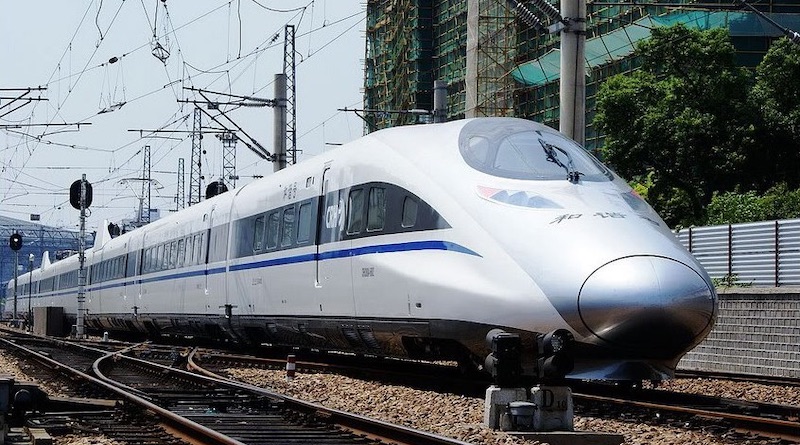
Top Speed: 217 mph (350 km/h)
Country: China
Operator: China Railway Corporation
Operating since: 2008
The CRH2 series is a power-distributed, AC-driven electric multiple-unit train that uses an aluminum alloy hollow profile body. It is based on the Japanese Shinkansen’s E2 series. In 2007, CRH2A won the first prize of National Railway Science and Technology Award, while its bogie technology won the first prize of National Science and Technology Progress.
The CRH3 train, on the other hand, is the Siemens Velaro platform derived from the German railway ICE-3 train. The CRH3C electric multiple-unit is power decentralized train that consists of four trailer cars and four motor cars, equipped with two driving units.
Both trains feature a rigid body that lowers the noise and vibration, optimized car window for better airtightness and strength, and enhanced pressure protection system to avoid pressure fluctuation in the compartment.
9. AVE
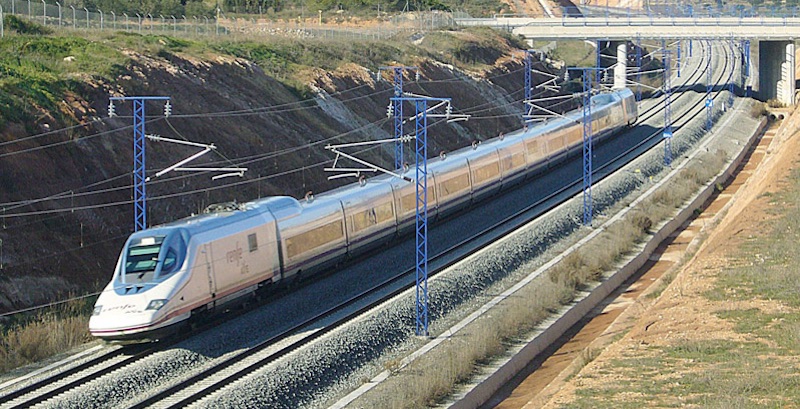
Top Speed: 217 mph (350 km/h)
Country: Spain
Operator: Renfe
Operating since: 2005
AVE (short for Alta Velocidad Española) is a service for high-speed rail operated by the Spanish national railway company, Renfe. The word ‘Alta Velocidad Española’ translates to ‘Spanish high speed’, and its short form ‘AVE’ means ‘bird’.
AVE trains — especially Class 102, 103, and 105 — are designed to run at speed of 193 mph (310 km/h), though they are capable of achieving much higher speeds. As of 2017, the AVE system is the longest high-speed rail network in Europe with 2,013 miles (3,240 km), and the 2nd longest in the world after mainland China.
Its new variant — Class 105 — is a non-articulated electric multiple-unit with distributed traction. The complete bodyshell is made of aluminum and each car has one powered bogie, with electric motors on both wheelsets. The 8-car configuration can generate a total power of 10,560 kW (14,160 hp).
8. Shinkansen E5 and H5 Series

Top Speed: 224 mph (360 km/h)
Country: Japan
Operator: JR East and JR Hokkaido
Operating since: 2011 and 2016
Both E5 and H5 series Shinkansen are Japanese high-speed trains that feature electric active suspensions.
The new generation E5 series trains are designed to be faster and more comfortable than ever before. It has a long nose that extends to 15 meters to the front, a state-of-art braking system that reduces the stop distance, even at high speeds.
The H5 series features a range of cold-weather improvements, including durable rubber to protect the connections between cars, improved snowplow on the lead units, and a stainless-steel underframe to protect the electronics.
Both trains have an identical maximum operating speed and share the same design. However, the E5 series can be differentiated from the H5 by the color of its bodyside stripe: E5 has a pink stripe while H5 has a lavender bodyside stripe. Another difference is E5 uses normal halogen headlamps (has whitish glow) while H5 series uses LED headlamps (has a yellowish glow).
Japan has also started testing its fastest-ever bullet train, which is capable of reaching 249 mph (400 km/h). However, it is not expected to enter operation before 2025.
7. AGV 575
Top Speed: 224 mph (360 km/h)
Country: Italy
Operator: Nuovo Trasporto Viaggiatori
Operating since: 2012
The AGV 575 (Automotrice Grande Vitesse) is a standard gauge, high-speed electric multiple-unit train manufactured by Alstom. It features large interior compartments, an HVAC system, and facilities such as live television and onboard internet.
The train combines articulated carriage architecture with synchronous permanent magnet motors and a distributed traction system. It uses aluminum alloys that reduce the overall weight of the vehicle by 1,500 pounds compared to using steel.
While the nose of the train is fitted with a kinetic energy absorption unit to provide collision protection, its rigid body and the semi-rigid link between cars offer extra safety in event of collision or derailment.
6. Bombardier Zefiro 380
Top Speed: 236 mph (380 km/h)
Country: China
Operator: China Railway Corporation
Operating since: 2012
The Zefiro is the new generation of very high-speed trains designed by Bombardier Transportation. They are one of the most economical and environmentally friendly trains, first introduced in China. Now they are about to enter service in Italy.
The Zefiro 380 is packed with numerous attractive features, including spacious and aesthetic interiors, an aerodynamic design that saves 20% of the total energy.
At present, a total of 85 trainsets are operated in China. Each train can accommodate up to 650 passengers in an 8 car setting and 1,336 passengers in a 16 car setting.
5. CRH380A Hexie
Top Speed: 236 mph (380 km/h)
Country: China
Operator: China Railway Corporation
Operating since: 2010
The CRH380A is designed to operate at a cruise speed of 217 mph (350 km/h), though it can attain even higher speeds. The original 8-car trainset can reach 302 mph (486 km/h).
The train has been redesigned for the new standard operating speed of 236 mph (380 km/h) on newly constructed high-speed main lines. It is based on a foreign design, but there have been some accusations that it used unlicensed Shinkansen technology.
The overall design of the train features low-resistance, streamlined head, highly pressurized tight body, advanced noise control technology, High-performance traction system, and regenerative braking with a maximum energy feedback rate of 95%
4. CRH380B/BL Hexie

Top Speed: 236 mph (380 km/h)
Country: China
Operator: China Railway Corporation
Operating since: 2011
The CRH380B/BL Hexie is a version of the Siemens Velaro high-speed train. Its maximum operating speed is 186 mph (300 km/h), though it is capable of attaining much higher speeds.
It is a new generation of high-speed electric multiple-unit trains developed on the basis of CRH3C. Compared to CRH3C, the continuous operation speed is increased from 186 mph (300 km/h) to 217 mph (350 km/h), the maximum design speed is increased from 217 mph (350 km/h) to 236 mph (380 km/h), and the maximum test speed is 249 mph (400 km/h).
The train’s aerodynamic shape and enhanced traction power greatly improve its performance. Moreover, the damping performance, cabin noise, and pressure control features have been made better over the years to provide more comfort inside the vehicle.
3. Frecciarossa 1000
Top Speed: 249 mph (400 km/h)
Country: Italy
Operator: Trenitalia
Operating since: 2015
Frecciarossa 1000 is the new high-speed train designed to meet the most advanced techniques. It can travel on all European high-speed networks and is suitable for long-distance passenger service.
It offers high-commercial speed of 223 mph (360 km/h), thanks to its 16 powerful engines distributed on all coaches. It can accommodate up to 485 passengers in four classes, which include tip-up seats for disabled people.
The train utilizes modern energy-saving technology and has several sustainable features. Up to 85% of the material used in this train can be recycled, while 95% of materials are renewable.
Read: Top 15 Fastest Aircraft In The World
2. Fuxing CR400AF/BF
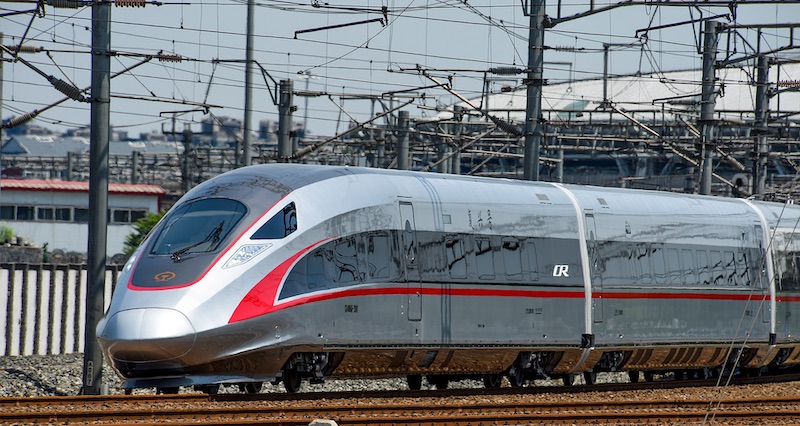
Top Speed: 261 mph (420 km/h)
Country: China
Operator: China Railway Corporation
Operating since: 2016
Fuxing is a series of electric multiple unit high-speed trains. Two of its variants — CR400AF and CR400BF — are world’s fastest non-maglev trains currently in service, with a design speed of 217 mph (350 km/h).
The name ‘Fuxing’ translates to ‘rejuvenation’ and each of the two variants have been assigned a nickname: CR400AF is ‘Blue/Red Dolphin’ and CR400BF is ‘Golden Phoenix’.
The train can carry 556 passengers and provides many facilities, including Wi-Fi access. It decreases energy consumption and adopts a standard part design. Compared to other electric multiple-unit trains, it has more reinforced safety features.
1. Shanghai Maglev
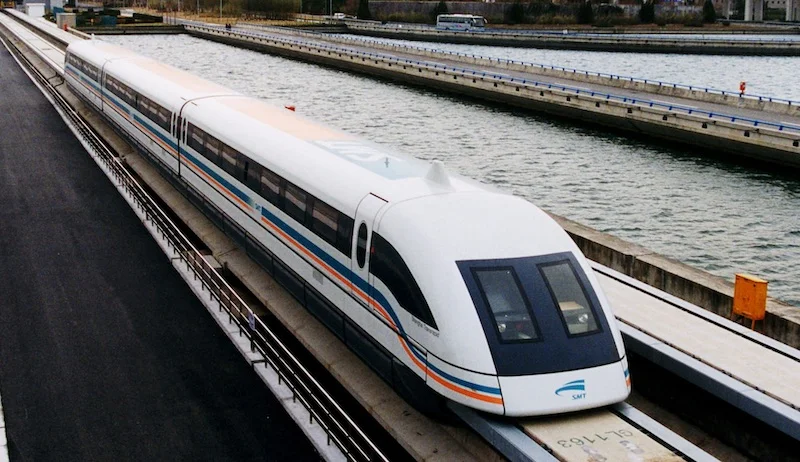
Top Speed: 268 mph (431 km/h)
Country: China
Operator: Shanghai Maglev Transportation Development
Operating since: 2004
Shanghai Maglev is the fastest commercial electric train in the world, built with technological help from Germany. It is the first and oldest commercial high-speed maglev still in operation.
The project took $1.3 billion and 2.5 years to complete. The line has 18.53 miles (20.5 km) track, plus a separate track for maintenance.
Read: China Reveals A Maglev Train Prototype That Goes Up To 600 Km/h
The business has not generated any profit to data. Due to the huge operating costs and the lack of passenger flow, Shanghai Maglev loses millions of dollar every year.
Flights might seem like the simplest mode of transport, but a ride on the fastest train in the world will challenge airplanes on travel time, not to mention efficiency. And while headlines may proclaim Japan’s L0 Maglev between Tokyo and Nagoya the fastest train ever, with a 313 mph average speed that cuts the time it takes to travel between the cities by half, it’s not scheduled to start service until 2027. So although there are faster ones in testing than those in this list of the fastest trains in the world, we’re only featuring high-speed rail currently in service, that you can actually ride right now.
Here are the world’s fastest high-speed trains in commercial service, ranked by speed.
1. Shanghai Maglev: 268 mph
The world’s fastest train isn’t the newest, the shiniest, or even the one with the most expensive tickets. Charging 50 yuan (about $8) per person, per ride (or double that for a “VIP” ticket in a slightly more spacious cabin), the Maglev runs the nearly 19 miles from Shanghai’s Pudong International Airport to the Longyang metro station on the outskirts of Shanghai. That’s right, the train—which takes just over seven minutes to complete the journey—doesn’t go to the city center. As such, the bulk of the passengers since its 2004 debut have been travelers on their way to and from the airport, cameras out and ready to snap a photo of the speed indicators when the train hits 431 km/hr (268 mph).
2. Fuxing Hao CR400AF/BF: 249 mph
China wins again, also serving as home to the world’s fastest non-Maglev train currently in service. The name “Fuxing Hao” translates to “rejuvenation,” and each of the trains have been branded with nicknames: CR400AF is “Dolphin Blue,” and the CR400BF is «Golden Phoenix.” (The “CR” stands for China Railway.) Both take just under five hours to zip up to 556 passengers each between Beijing South and Shanghai Hongqiao Station, easily halving the nearly 10-hour time it takes to ride the conventional, parallel rail line between these two megalopolises. The lines served by these trains have greatly expanded over the last several years, with newer routes including Jinan-Qingdao and Guangzhou-Zhuhai, and a 2018 debut of what remains the world’s longest high-speed rail route, from Beijing to Hong Kong in nine hours.
3. Shinkansen H5 and E5: 224 mph
A bullet train pioneer, Japan debuted the Hikari high-speed train launched service between Tokyo and Osaka way back in 1964 that, cutting travel time between the country’s two largest cities from nearly seven hours to a mere four by rail. The H5 and E5 series Shinkansen, respectively running the Tohoku and Hokkaido services, are two of the newer bullet trains on Japan’s tracks, and they’re expected to make their international debut on India’s first high-speed rail line, connecting Mumbai and Ahmedabad, in 2026.
The Italo train whisks riders from Rome to Milan in just over three hours.
Andreas Solaro/Getty
4. The Italo and Frecciarossa: 220 mph
Italy’s dueling train operators, NTV and Trenitalia, each flaunt a high-speed train that tie as Europe’s fastest, capable of shuttling passengers around much of the country far faster than by car. An international route from Milan to Paris, taking six hours, has proved to be so popular that Trenitalia has increased their daily frequencies. The Frecciarossa, or “red arrow,” was unveiled during Expo 2015, held in Milan, and the train is remarkable as much for its speed as for its construction; its components are nearly 100 percent renewable and sustainable.
5. Haramain Western Railway: 217 mph
The Mecca-Medina high-speed link stretches the 281 miles between Saudi Arabia’s most holy cities and was fully completed in 2018. Traveling the length of the route takes two and a half hours, compared to five hours by car. Speed isn’t the entire justification for the construction of this railway, however; the Haramain carries millions of passengers a year, including many Hajj and Umrah pilgrims, relieving traffic congestion. In 2019, Saudi Arabia announced plans to triple the size of its rail network by adding nearly 5,000 miles of new track, although not all will be high-speed.
6. DeutscheBahn ICE: 205 mph
The distinctively futuristic white and silver of the Inter-City Express, or ICE, combined with its sharp red cheatline, makes an impressive sight speeding through scenic German countryside. And, with Deutsche Bahn placing more and more orders for them, they’ll become quite a common sight by 2030, when some 450 ICE trains run on Europe’s rails. Similar to Spain’s Renfe AVE train, Germany’s fastest train is a Siemens design, the Velaro, and was built to fit through the Channel Tunnel. This fact is important as DeutscheBahn has long-term plans to operate these trains from Frankfurt to London.
7. Eurostar e320 and TGV: 200 mph
Both the TGV and Eurostar e320 trains are tied for next on the list, but the latter underwent a redesign in 2015. Named for its top speed of 320 km/hr (200 mph), the e320 series is the first tip-to-tail redesign of a Eurostar train in the company’s 22 years. The speedier trains—20 km/hr faster than the earlier, e300 series—are capable of trimming another 15 minutes off the already zippy Eurostar trips of around two hours between Brussels, Paris, and London, and cutting the comparatively lengthy ride from London to Amsterdam to under four hours.
8. Al Boraq: 198 mph
Named for a winged horse animal from Islamic lore, Al Boraq puts Africa on the list of fastest trains with an hourly, 116-mile service between Tangier and Kenitra, in Morocco. From Kenitra, it must slow down to travel on regular tracks into the Casablanca terminus, but the entire journey is still sliced in half, from almost five hours of travel time to just over two hours. Debuting in 2018, the train’s destinations are expanding as the rail infrastructure is upgraded for high-speeds, with Rabat next on the list.
9. Renfe AVE: 193 mph
Spain’s fastest train is the Velaro E by Siemens, and it is used for long-distance services to major Spanish cities and beyond: traveling from Barcelona to Paris can now be accomplished on high-speed rail in six hours.
10. Korail KTX: 190 mph
South Korea’s high-speed rail network may not be the newest (the KTX, or “Korean Train Express,” debuted in 2004) or the shiniest, but it does hold its rank among the fastest. In 2018 the train enabled athletes and spectators to reach the Pyeongchang Winter Olympics direct from Incheon International Airport, cutting the journey from six hours to under two. The newest route, on the Jungbunaeryuk Line connecting Bubal and Chungju, cuts through the center of the country to reach a region cherished for its mountains, caves, and natural springs.
This article has been updated with new information since its original publish date.
The Briefing
- Prevalence of ADHD, substance use disorders, and mood disorders appears to be higher in entrepreneurs than in the general public
- One-third of entrepreneurs reported two or more co-occurring mental health conditions
The Link Between Entrepreneurship and Mental Health Conditions
Entrepreneurship has long been associated with traits like risk-taking, persistence, and creativity. It’s no surprise, then, many of the world’s most successful companies were brought to life by neurodivergent founders.
Neurodivergence refers to natural differences in brain function among individuals with conditions such as autism, ADHD, dyslexia, and bipolar disorder. As this 2019 study demonstrates, entrepreneurs appear to experience mental health and addiction issues more frequently than the general public, and tend to have families with these illnesses at a higher rate.
Nearly half of entrepreneurs included in the study have one or more mental health conditions. Below the are the numbers for four of the conditions studied.
| Entrepreneurs | General Sample Group | |
|---|---|---|
| ADHD | 29% | 5% |
| Depression | 30% | 15% |
| Bipolar | 11% | 1% |
| Addiction | 12% | 4% |
The research also looked at anxiety, but found that levels were similar between entrepreneurs and the sample group.
Obsessive-compulsive disorder (OCD), dyslexia, and Asperger’s Syndrome, which are not included in this research, are other noteworthy conditions that are sometimes connected with entrepreneurship.
Asperger’s, in particular, is present in a number of successful founders, including Elon Musk and Bill Gates. Peter Thiel, billionaire investor and serial entrepreneur, has argued that this mild version of autism could be an asset in founding successful companies.
An Open Question
There are two competing ideas around the link between entrepreneurship and mental health conditions.
First, some posit that traits associated with mental health conditions (e.g. hyperfocus for ADHD, or attention to detail for Asperger’s) are assets in the startup world.
Secondly, it is also thought that because neurodivergent individuals have more trouble succeeding in conventional frameworks in academia and business, they are more likely to forge their own path by founding companies and pursuing self-employment.
It’s entirely possible that both these ideas are true. The more research that is published around mental health and entrepreneurship, the clearer view we have on the traits associated with creating successful businesses.
The more open the conversation is around mental health, the more we can create conditions in the workplace that empower neurodivergent individuals.
Source: Freeman, M.A., Staudenmaier, P.J., Zisser, M.R. et al. The prevalence and co-occurrence of psychiatric conditions among entrepreneurs and their families. Small Bus Econ 53, 323–342 (2019).
Data notes: Data was analyzed from 76 MBA student and faculty pool participants, 149 psychology students, and 110 entrepreneurs not affiliated with the university. Participants from either recruitment group who reported a history of self-employment or founding or co-founding a for-profit or non-profit business were categorized as entrepreneurs (n = 242).
Hat tip: We discovered this research via The Generalist who published a fantastic post on who becomes an entrepreneur.
Nowadays some high speed trains are challenging aeroplanes in terms of speed and service. While Japan is known for its supreme version of bullet trains, China’s high speed trains rank top with speed up to 350 km/hr. High speed trains of Europe are offering more comfortable journey than the flight. The list of fastest trains in the world has been discussed below.
Here are the 15 fastest and high-speed trains in the world, ranked by service speed:
The World’s Fastest Train
Fastest Train #1- Shanghai Maglev: 430km/hr
The amazingly fast speed train Shanghai Maglev has been operated commercially in China since 2004. The world’s first maglev train runs from Pudong international Airport to Longyang rd. station. Shanghai maglev, operated by Shanghai maglev Transportation Development Co. , was constructed by the collaboration of Siemens and Thyssenkurpp.
The maglev train covers 19 miles within only 7 minutes using magnetic levitation technology. The fare of train ticket is $8 per person, per ride.
Also Read : Train 18 – Interesting Things About India’s Fastest Train
Fastest Train #2 – Fuxing Hao CR400AF/BF: 249 miles/hr
The fastest non-maglev train in the world is Fuxing Hao CR400AF/BF, which runs from Beijing South station to Sanghai Hongqiao station in China. The word ‘Fuxing hao’ means rejuvenation. The two trains CR400AF and CR400/BF have been branded with nicknames ‘Dolphin Blue’ and ‘ Golden Phoenix’ respectively.
Both trains running at the speed of 249m/hr covers 819 miles in just 5 hours. The conventional trains take 10 hours to cover the same distance. Each train carries 556 passengers from Beijing to Sanghai. Fuxing Hao beats Harmony CRH380A, China’s next fastest train.
Also Read : Indian Railways is Launching Train 19 Soon This Year
Fastest Train #3 – Harmony CRH 380A: 236 miles/hr
Harmony CRH 380A, an electric and multiple unit train, is one of the fastest trains in the world having the high speed of 236 miles/hr. Since 2010, the China railways Harmony CRH 380A has been in operation commercially between Sanghai and Nanjing route.
The joint venture of CSR Qingdao Sifang Locomotive and Rolling Stock company constructed this high-speed train. Alluminium body and long nose could minimize aerodynamic running and pressure.
Having the capacity of carrying 494 passengers at a time, this train serves its passengers food, drinks, facilities like an electronic display and reading lamp.
Must Read: 10 Interesting Tips for Booking Luxury Trains in India
Fastest train #4 – Maharajas’ Express : 150 kmph
This luxury train is one of the fastest luxury trains in the world that covers several top tourist destinations in India on various trips. It travels at a speed of 150 kmph and is popular as the ‘Richest Train in India’ making the travelers feel like they are traveling in kingly ambiance.
Guests who like to see India need not worry about food and accommodation as all are included in the fee. There are basic amenities such as attached washrooms with running water, various accommodation categories, 2 top restaurants onboard, a bar and a fitness cum health spa center on the Maharajas Express train.
Before booking must Know : What is Maharajas’ Express Train?
Request a Quote
Know about the Maharajas Express:
- Maharajas Express train fare
- Maharajas Express train departure dates
- History of Maharajas Express train
- Route map of Maharajas Express train
- Maharajas Express train restaurants
- General Information of Maharajas Express train
Also Read : 15 Most Interesting Facts to Know Before Boarding the Maharajas Express Train
Fastest Train #5 – Shinkansen E5 and H5: 224m/hr
The fastest high-speed train in Japan, Shinkansen E5 and H5, started its operation from 5th March 2011. The train, owned by East Japan railway company, runs from Tokyo to Aomori covering the distance of 444miles in just 2hr. 56 minutes. The train runs at the speed of 224 miles/hr. This train is characterised by 15 m. long nose, which minimizes the sound blast in tunnels. Full active suspension system in this train reduces vibration of the moving compartments.
Read More: A Complete Comparison of the Famous Luxury Trains in India
Fastest Train #6 – AGV Italo:223 m/hr
AGV Italo is one of the fastest trains in the world and the fastest train in Europe. This high-speed train with the speed of 223miles/hr runs from Rome to Naples covering the distance of 140 miles in less than one hour. This multi unit train is eco-friendly because 98% of its body parts are recyclable.
Being manufactured by French company Alstom, this train was purchased in 2008 by Italian company Nuovo Transporto Viaggiatori. The Italian company bought 25 tains in lieu of Euro 650 milion.
Also Read: 15 Most Luxurious Experiences in India
Fastest Train #7 – Siemens Velaro E/AVS 103: 217miles/hr
German engineering company Siemens manufactured Velaro E high-speed trains. Velaro E trains are known as AVS 103. The Velaro E with high-speed of 217 miles/hr runs between Barcelona and Madrid covering the distance of 385 miles in just 2 hours 30 minutes.
In 2001, the Spanish National Railways purchased the Velaro E trains. This train has been in operation commercially since 2007. The capacity of carrying passenger of this train is 404.
Suggested Read: List of Luxury Trains in India That Redefine Royal Journeys
Fastest Train #8 – Taglo 350: 217miles/hr
Taglo 350 is one of the fastest trains in Spain as well as the world. It runs between Barcelona and Madrid at the speed of 217miles/hr. The state run railway company operates its functions.
Taglo 350 is designed in such a way so that this train can handle pressure waves. There are 12 passenger cars and two driving cars in this train. The four classes in this train- First class, Club class, Coach class and Bistro class have comfortable seats with footrests.
Further Read: Experience Exotic Train Journeys in Worldwide
Fastest Train #9 – Korail KTX: 205 miles/hr
South Korea’s high speed train Korail KTX runs at the speed of 205 miles/hr. Its new route from Incheon International Airport to coastal town of Gangneung is covered in just 2 hours by the train. It beats the conventional train, which takes around six hours to cover the same distance. This new route was opened during 2018 Winter Olympics.
Also Read : Do you Know About Toy Trains in India
Fastest Train #10 – Deccan Odyssey
Deccan Odyssey offers several facilities from high speed internet to soft beds to sleep on in these imperial carriages based on the theme of the Maharajahs of Yore. This semi high speed luxury train takes guests through the heritage sites of India, famous western coasts, old churches, centuries old temples, and UNESCO World Heritage Sites in fully air conditioned cabins done up richly.
There is everything luxurious onboard including an Ayurveda Spa center, restaurants that serve delicious food, a panoramic view from the window, different accommodation cabins to suit your requirements, washrooms with full amenities, etc. It may not be the highest speed train but takes guests to tour the oldest and fascinating tourist spots in India.
Request a Quote
Complete details of Deccan Odyssey:
- History of Deccan Odyssey train
- Route map of Deccan Odyssey train
- Coaches of Deccan Odyssey train
- Deccan Odyssey train fares
- Deccan Odyssey train schedule
Fastest train #11 – Alstom Euroduplex: 198.8 miles/hr
The multi system, double checked, high speed trains, Euroduplex trains are operated by the French railway company SNCF. The trains run through France, Switzerland, Germany and Luxembourg at a high-speed of 198.8 miles/hr. This train has been in operation since 2011.
The Alstom railway company has designed Euroduplex trains in such a way that the trains can carry 1020 passengers at a time. Lower power consumption and light body weight with improved aerodynamics are special features of these trains.
Also Read: How Many Types of Trains Are There in India?
Fastest Train #12 – SNCF TGV Duplex: 198.8 miles/hr
In France, TGV Duplex train started its operation in December 2011. With high speed of 198.8 miles/hr, this train run through all main cities of France. Multi-system, double check high speed train can carry 508 passengers at a time. This train is operated by the SNCF railway company. Aluminium body, eco-friendly design, stiff passenger compartments are special features of this train. This train ensures safety to its passengers. TGV Duplex trains are manufactured by Alstom manufacturing company.
Fastest Train #13 – Palace on Wheels
This luxury train that may not be one of the top fastest trains in the world but is special in a luxurious way. It has two restaurant cars, a bar, a lounge, various accommodation cabins to suit the guest’s needs. The Palace on Wheels takes guests to popular tourist destinations in India, UNESCO World Heritage Sites, palaces and monuments like the Taj Mahal, Agra Palace, etc.
Guests also go on off-board sightseeing tours to such places as the train makes its way to other station where they board. In addition, guests can also go on a wild safari in India, engage in interesting activities like camel ride, etc. Book tickets for Palace on Wheels earlier to avoid any last minute rush!
Request a Quote
Some Information of Palace on Wheels:
- Palace on Wheels itinerary
- Coaches of Palace on Wheels train
- Palace on Wheels restaurant
- Palace on Wheels cabins
- Route map of Palace on Wheels train
- Palace on Wheels train cost
- Palace on Wheels schedule
Related Posts:
- 15 Most Beautiful and Impressive Railway Stations in India
- Dream it, Book it, Experience it – Palace on Wheels Train
- Maharajas Express – Royal Interior of The Luxury Train
- Different Types of Trains in India
- List of Luxury Trains in the World
You may be surprised to learn that it’s not just automobiles and airplanes that are capable of incredible speeds. Trains running can actually pin you against the back of your seat and travel hundreds of miles in the blink of an eye.
Spain, Germany, Italy, Belgium and England are expanding the European network with other countries expected to follow by the 2030s, CNN reports. South Korea, Saudi Arabia and Taiwan have established high-speed routes. India, Thailand, Russia and the United States are committed to building new railways where trains will travel at speeds of more than 250 kph (155 mph).
1. Shanghai Maglev – 460 kph/286 mph (China)
In the world of trains, China has the largest high-speed rail network. The Asian giant has the longest high-speed line on the planet (from Beijing to Guangzhou-Canton, 2,300 km), the highest (the bullet train to Tibet, at an altitude of 5,000 meters) and has in the pipeline the train that intends to break all records: a bullet train that could reach 620 km/h (620 mph).
Although not a traditional train in the usual sense, Maglev trains are still technically vehicles that run on tracks. These trains use a system of magnets to float above the track to avoid the problem of friction. Maglev trains are also interesting because there are no moving parts besides the train itself. This means that these trains are not only faster than conventional trains, but also quieter.
In 2015, an L0 Maglev series train from Japan broke the record for the “world’s fastest manned train” by achieving a record of 370 mph. That same month, it ran again and set a new record of 375 mph.

2. CR400 ‘Fuxing’ — 350 kph/217 mph (China)
The Fuuxing Hao is a network of high-speed trains running on conventional railroad tracks. These high-speed trains have their own names and CR400AF is known as Blue/Red Dolphin.
This train is one of the fastest conventional trains in the world that is in regular use and commercial service. It operates at a top speed of about 217 mph, but during testing achieved a top speed of 270 mph.

3. ICE3 — 330 kph/205 mph (Germany)
The Intercity Experimental was developed as an experimental train in the 1970s in Germany. It was created to investigate high-speed trains for the country.
After a series of tests, researchers managed to push one of the variants to 310 mph. Of course, this was not a realistic standard running speed, but in 1988 the new Intercity-Express trains broke land speed records for rail vehicles when they exceeded 252 mph.

4. TGV — 320 kph/198.5 mph (France)
This train seems to have a bit of a complicated name. But for the most part they are all acronyms. SNCF is the state-owned rail operator in France and TGV stands for Train à Grande Vitesse, which translates as “high-speed train.” A fitting designation since this train not only breaks records, but is also part of the country’s high-speed rail network. Meanwhile, POS stands for Paris-Ostfrankreich-Süddeutschland, which gives you an idea of how far the train travels – Paris, eastern France and southern Germany.
This train uses motor cars with a total power of about 12,900 hp. In 2007, this train set a world speed record by traveling on conventional rail lines at a top speed of 574.8 km/h.

5. JR East E5 — 320 kph/200 mph (Japan)
Japan introduced the world to the concept of new high-speed railroads in 1964 and continues to be a world leader, pushing the limits of speed, capacity and safety on its Shinkansen lines.
While most Shinkansen currently operate at a maximum of 300 kph (186 mph), Japan Railways East’s (JR East) E5 “Bullet Trains” run up to 320 kph (200 mph) on the Tohoku Shinkansen, which runs north from Tokyo. to Shin-Aomori.
Each train has 731 seats and 32 induction electric motors delivering an impressive 12,900 horsepower. Constructed of lightweight aluminum alloy, the E5s have “active suspension,” allowing them to negotiate curves at higher speeds.

The extraordinarily long nose of the driving cars was designed to reduce the sonic booms created when trains enter tunnels at high speed. Introduced in 2011, 59 trains were built and since 2016 have also been used north of Aomori on the Hokkaido Shinkansen, which is connected to Japan’s main island of Honshu by the 54-kilometer (33.5-mile) Seikan underwater tunnel under the Tsugaru Strait.

